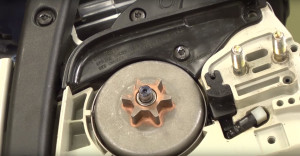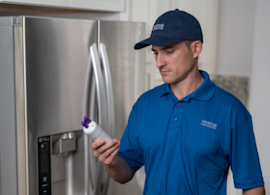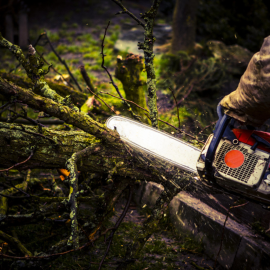How to replace a chainsaw oil pump video


A chainsaw that leaks oil probably needs a new oil pump. This video takes you through how to do that.
For help diagnosing chainsaw problems and for step-by-step repair guides, see our chainsaw repair help.
Undertaking repairs to appliances can be hazardous. Be sure to use the proper tools and safety equipment notes in the guide and follow all instructions. Do not proceed until you are confident that you understand all of the steps and are capable of completing the repair. Some repairs should only be performed by a qualified technician.
If your chainsaw is leaking bar and chain oil when not being used, chances are the pump is worn and needs to be replaced. This oil pump replacement procedure applies to most chainsaws.
Tools and equipment you need
The only part you need is an oil pump, which you can order online at Sears PartsDirect or by calling 1-888-873-3829. Write down the exact model number from your chainsaw include dashes, periods and other characters. You will need this complete number to ensure you order the correct parts.
The tools you need to replace the pump are the following:
Safety glasses
Work gloves
Wrench to remove the clutch cover
Spark plug wrench
Needle-nose pliers
Flat-blade screwdriver
Phillips screwdriver
T25 torx screwdriver
Hammer
Hole punch
Besides these tools you'll need a large, organized work area, shop rags or paper towels, an empty oil bottle to drain the remaining oil, a funnel and a piece of soft rope. We're using a 1/4-inch piece about a foot long.
Remove the spark plug
Remove the top cover. Disconnect the spark plug wire and tuck it out of the way. Then remove the spark plug with the spark plug wrench.
Remove the clutch cover and chain
Now remove the clutch cover bar and chain with gloved hands and the wrench. The instructions for removing that clutch cover bar and chain can be found in your owner's manual.
Drain the oil
When you are ready to start the repair, remove the oil fill cap. While holding the funnel in the empty oil bottle, tip the chainsaw over the funnel to drain any bar and chain oil left in the chainsaw. Once it is drained, seal the bottle so it doesn't accidentally spill.
Pour the oil into a sealed container and dispose it in accordance with applicable law. Most Sears automotive stores accept used oil for recycling. Call your local Sears Auto Center for details.
Remove the clutch
Next, remove the clutch drum retaining clip with a flat blade screwdriver. Keeping one finger on the clip while removing it prevents it from flying off and getting lost.
Slide the washer and the clutch drum off the end of the crankshaft. When taking the parts off, take them from left to right on the work surface to aid in reassembly later.
Now look into the spark plug hole while pulling the starter rope slowly. Once the piston is at the top of the cylinder, stop pulling the rope.
If you try to remove the clutch now the crankshaft would turn with it. To keep the crankshaft from turning, feed the soft rope into the spark plug hole. Be sure to leave a little hanging out for easy removal later. Now turn the clutch with a gloved hand clockwise until it will not turn any further.
Once the engine is locked, you can use the hammer and punch to remove the clutch. Place the end of the punch against one of the wings on the clutch so that it will turn the clutch clockwise. Tap the punch with the hammer to break the clutch loose. Then spin the clutch off the end of the shaft and remove the large washer behind the clutch.
Remove the handle and chain brake
Now remove the T25 torx screws that secure the handle. Then remove the handle from the chainsaw.
Next the chain brake needs to be removed. Use the T25 torx screwdriver to remove the screw securing the chain brake. Remove the chain brake and set it aside.
Remove the pump
Before removing the screws for the pump, wipe the area clean with a shop rag or paper towel. If you happen to have an air compressor you can blow this area out.
Once the area around the pump is clean, remove the two Phillips head screws securing the pump. Next use a pair of needle nose pliers to pull the pump out. Then disconnect the hose from the oil tank pick up. Now use a straight blade screwdriver to pry the pump drive off the crankshaft. The pump drives a tight fit so it takes a little work to remove it.
Install the new pump
Before installing the pump, wipe down with the shop rag or paper towel. Be sure to get the area as clean as possible to prevent sawdust from plugging the new pump.
After the area is clean, use the deep socket or small piece of pipe to push the new pump drive on the crankshaft. Be careful not to make the seal on the crankshaft.
After you have the pump drive installed, connect the hose to the oil tank pickup then slide the new pump over the crankshaft, making sure to align the rubber housing onto the frame assembly. Now secure the new pump with the two Phillips head screws.
Reinstall the chain brake and handle
Next position the chain brake onto the frame. Then secure it with the T25 torx screw.
Position the handle onto the chainsaw and secure with the T25 screws.
Reinstall the clutch
Then install a large washer onto the crankshaft followed by the clutch. The clutch only has to be hand tight.
Next slide the clutch drum onto the crankshaft and ensure it spins freely. If it is free, put the washer and the retaining clip on the crankshaft. You will need to use needle- nose pliers to reinstall the retaining clip. Now pull the soft rope out in the cylinder.
Reinstall the spark plug
To ensure that everything was assembled correctly, pull the starter rope a few times. If the engine turned easily, install the spark plug by hand. Then tighten the spark plug.
Now reattach the spark plug wire and reinstall the top cover.
Reinstall the chain and clutch cover
With gloved hands install the bar chain and clutch cover. Be sure to follow the instructions in your owner's manual on installing the bar, chain and cover.
Fill with oil
Now refill the oil tank and check the operation at new pump. That's all there is to replacing the pump on your chainsaw.
Symptoms for gas chainsaws
Choose a symptom to see related chainsaw repairs.
Main causes: cracked fuel lines, leaky carburetor seals, damaged fuel tank cap, cracked fuel tank…
Main causes: bad gas, engine needs tune up, cracked fuel lines, dirty carburetor…
Main causes: stale gasoline, cracked fuel lines, dirty carburetor, damaged spark plug, worn piston rings…
Repair guides for gas chainsaws
These step-by-step repair guides will help you safely fix what’s broken on your chainsaw.

How to rebuild a chainsaw carburetor
If your chainsaw isn't running well, a dirty carburetor could be the problem. You can take it apart, clean it and rebuil…

How to replace a chainsaw carburetor
If the engine won't start even though there's fuel in the chainsaw, the carburetor could be the problem. Sometimes, it's…

How to replace chainsaw fuel lines
The fuel line on a chainsaw becomes brittle over time and can crack. Replacing it doesn't require a lot of DYI experienc…
Articles and videos for gas chainsaws
Use the advice and tips in these articles and videos to get the most out of your chainsaw.

Learn about all the convenient features on our Sears PartsDirect website that make your parts purchases easier.…

Get answers to frequently asked questions about Sears and Sears PartsDirect.…

Learn the basics of taking care of your chainsaw and solving common problems.…